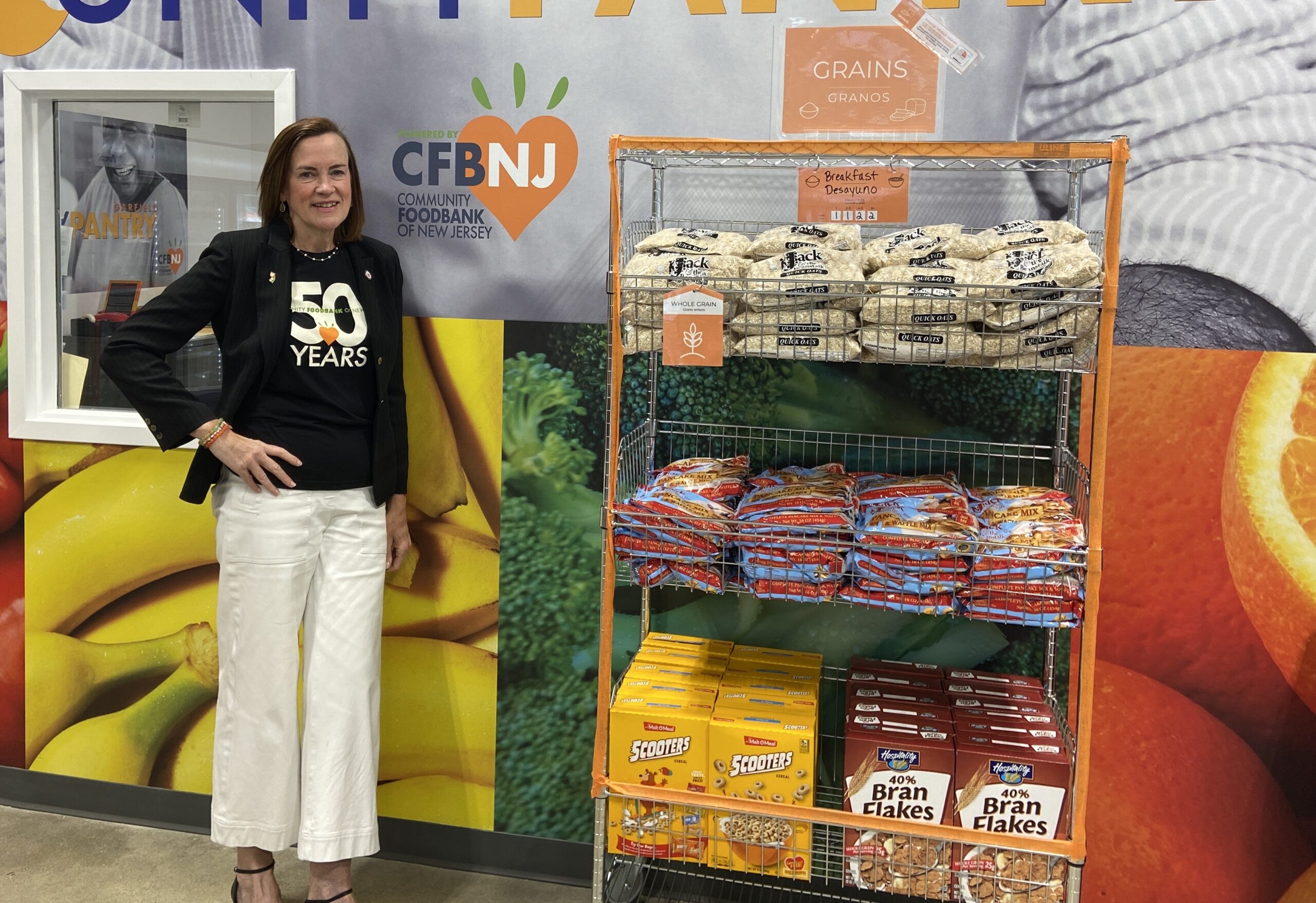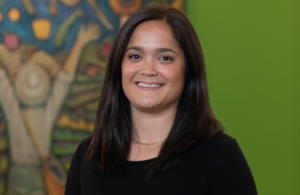Just over a year into leading the Community Food Bank of New Jersey, Elizabeth McCarthy is proving to be a quick study of hunger relief, while also putting her own spin on things.
McCarthy became President and CEO of CFBNJ last July, following decades of working at various multi-service nonprofits, including one that dipped into food distribution during the pandemic. Being able to deliver food alongside other social services was an activity that resonated with McCarthy, helping to draw her into her current food banking role.
“That’s exactly what I wanted to get involved in,” she said.
McCarthy hasn’t wasted any time in pairing food with other social services, putting CFBNJ in line with an overall trend in hunger relief. Last week, she hosted the grand opening of a pantry run by CFBNJ that will be co-located with other organizations offering low- and no-cost healthcare, subsidized mental health, Head Start education, and other social services. Close to public transportation, the new Unity Pantry has extended hours, SNAP sign-up assistance, and targets an area previously underserved by charitable food.
Planning and rolling out the pantry has unfolded at the same time that McCarthy has been immersed in addressing the main goals of the strategic plan she inherited. In what may be an indication of how much work there is to be done, the first priority listed on the plan is for CFBNJ to fulfill the basics – being a reliable and dependable partner to its roughly 400 agency partners and 400 program partners, in terms of accurately filling orders and delivering them on time.
McCarthy doesn’t take the issue lightly. New automation in the warehouse and routing and reporting software for the trucks is giving the food bank more information about its own logistics performance. And data mapping is letting it better understand how well its current network of agencies matches up against the highest areas of need throughout its 11-county service area.
McCarthy is also inviting partner agencies to cast their own critiques of the food bank’s performance. A Partner Collaboration Council of about 35 partners now meets regularly to discuss a wide range of issues. And any partner agency can also attend county-wide listening sessions held via Zoom.
The food bank is phasing in a report card in the form of short, quarterly “pulse” surveys that will let partner agencies report back on how well the food bank is meeting their needs. “I like when people tell me what we’re not doing well, because it gives us a chance to be able to address it,” McCarthy said. She added, “We really want to be a reliable partner to our partner agencies.”
Like many food banks, CFBNJ is outgrowing its current warehouse and already rents space in two other locations to accommodate cold storage. While a move toward bigger warehouses is a strong pull in food banking these days, McCarthy is taking a measured approach. In her view, minimizing the need for warehousing food in the first place is optimal. “Honestly, the less food that enters here the better,” she said.
By moving food directly from producers to pantries, the food bank can avoid having to warehouse it. CFBNJ already has partnerships with about 30 local farmers and other producers, including socially disadvantaged ones, and is aiming to have the food they produce go directly to partners. “Especially when it’s produce, a partner can pick it up in the morning and hand it out to neighbors in the afternoon,” McCarthy said. “And it saves that time and lack of efficiency of bringing it here, having to sort it and then redistribute it.”
Other ways to avoid warehousing food include identifying larger pantries that can distribute food to smaller ones nearby. Similarly, CFBNJ is having produce distributors in more distant regions deliver directly to nearby partners, rather than ship the food to the central warehouse only to be sent out again.
All of these logistical initiatives will be factored into the warehouse plan. “We definitely need to renovate or move,” McCarthy said. “But before we make any huge investment, we want to make sure we know exactly what we need and that we’re not overbuying.”
In addition to the aging warehouse, McCarthy inherited a variety of programs, some of which have been expanded. Its workforce training program now includes a course on warehouse logistics, in addition to culinary training. The courses are free to students, with the food bank providing monthly bus passes or $78 a month in gas money to cover transportation costs.
Health initiatives are another focus. Working with its Partner Collaboration Council, the food bank recently released its first nutrition policy, which will help agencies select foods that should be eaten often, sometimes or rarely. The goal is to have 95% of foods selected by agencies be those that should be eaten often or sometimes, “so everybody will have healthier foods on their shelves,” McCarthy said.
The Food Health Hope initiative, in partnership with a local healthcare provider, screens individuals for chronic conditions like diabetes and hypertension, and provides healthy food and produce boxes to those who qualify – nearly 7,000 boxes in all last year.
Based on an evaluation, the food bank may be modifying that program a bit. It has observed that the most important aspect of the diabetes program is being able to alert people, usually for the first time, that they are diabetic or have another chronic condition. Once they know, they are likely to choose the healthy foods they need, making distribution of the actual food boxes less important, McCarthy said. “What really matters most is the screening and the initial nutrition education,” she noted, “so we may focus more on that.”
Focusing beyond food may be a relatively new concept in food banking, but is not a stretch for McCarthy, given her background in multi-service nonprofits. “As much as we’re very proud of distributing over 100 million pounds of food, that’s not the answer in the long run,” she said. “When people come to us, we’re not just handing them food and saying goodbye. We’re saying, ‘What else in your life do you need help with?’” – Chris Costanzo
PHOTO, TOP: Elizabeth McCarthy, President and CEO of Community Food Bank of New Jersey, at the grand opening of the food bank’s Unity Pantry.
Like what you’re reading?
Support Food Bank News









